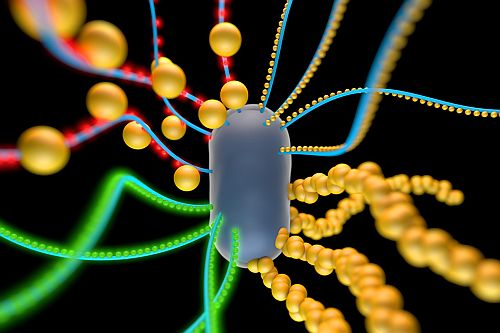So far, we have seen robots inspired from the best of biomimicry. Researchers have often looked upon nature to solve problems. At the same time, there are certain natural tendencies, which engineers are still trying to figure out the way towards artificially re-invention and one of them is ‘bone’.
Bone is one of those natural materials that require no supervision, yet it fabricates material in response to environmental signals. In order to understand this phenomenon, researchers at the MIT, have tried to juxtapose living bacterial cells with non-living substance like gold nanoparticles & quantum dots to generate biofilms.
Materials Synthesis
The experiment was carried out with bacteria named E.Coli. This bacterium was specifically used because it is capable of producing amyloid proteins based biofilms, also known as the “curli fibers”.
Like fractal, every fiber is made of up protein based CsgA, and by adding peptides, the resultant substance could be manipulated for capturing nonliving materials like gold nanoparticles.
Hence, by artificially modifying the core or curli fibres, the engineers were able to control the intrinsic properties of the biofilms. For instance, they were able to demonstrate gold nanowires conducting biofilms and biofilms integrated with minute crystals, which show an evidence of quantum mechanics.
They also went a step further, where they could change the overall composition of the biofilms.
Taking Control of E.Coli’s Internal Environment
Right at the beginning, the engineers immobilized the bacterium’s capability of producing CsgA. They reinstated it with an artificial genetic circuit that could fabricate the protein under specific condition and that is, in the presence of AHL. Hence, taking full charge of the “natural” phenomena, the researchers introduced certain amount of AHL into the cell’s environment, which responded by generating curli fibres that further morphed into a biofilm.
In the second experiment, the researchers wangled the cell to fabricate CsgA with peptides but this time in the presence of aTc.
Therefore, the researchers were able to take control of the basic composition of the biofilms by changing the quantities of AHL and aTC as per the requirements.
Upon establishing the colonies together from the two types of cells, the researchers observed that they were able to generate biofilms of tagged and untagged fibres. If gold nanoparticles were introduced to the cell’s internal environment, the offshoot will be of gold nanowires, and a network that would conduct electricity.
Coordination Amongst Cells
The mechanism also showed that cells coordinate with one other in terms of the biofilm’s composition. Researchers engineered cell to produce untagged CsgA and AHL. This process kindled other cells to initiate created histidine-tagged CsgA.
A similar phenomenon is observed in bones as well, it produces material as per the signals that it receives from environment there is no such supervising authority that controls the workings.
Researchers envision that this technique would help cure self-healing process, assist in devising designs like solar cells and diagnostic sensors.




